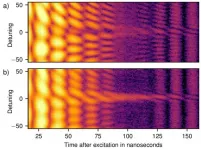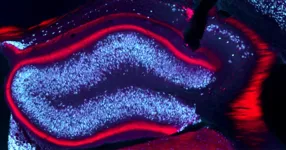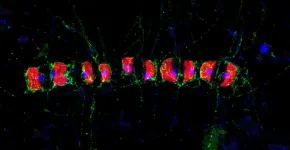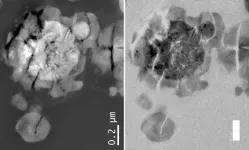(Press-News.org) The latest observations from Insight-HXMT were published online in Nature Astronomy on Feb. 18. Insight-HXMT has discovered the very first X-ray burst associated with a fast radio burst (FRB) and has identified that it originated from soft-gamma repeater (SGR) J1935+2154, which is a magnetar in our Milky Way.
Insight-HXMT is the first to identify the double-spike structure of this X-ray burst as the high energy counterpart of FRB 200428. This discovery, together with results from other telescopes, proves that FRBs can come from magnetar bursts, thus resolving the longstanding puzzle concerning the origin of FRBs.
These results from Insight-HXMT also help explain the emission mechanism of FRBs, as well as the trigger mechanism of magnetar bursts.
This work was conducted by scientists from the Institute of High Energy Physics (IHEP) of the Chinese Academy of Sciences, Beijing Normal University, University of Nevada Las Vegas, Tsinghua University and other institutions.
FRBs, first discovered in 2007, are a great mystery in astronomy. They release a huge amount of energy in only several milliseconds. About a hundred such events have been detected in different regions of our universe. Moreover, repeated FRBs have been found from the same direction.
Considering the narrow field of view of radio telescopes, the event rate of FRBs is very high: Every day thousands of such bursts reach Earth. However, before this discovery by Insight-HXMT and several other space X-ray instruments, no FRB radiation at any other wavelength had ever been detected, and all FRBs with fairly good localization were from distant extragalactic sources, whose identity and nature are yet unknown. The origin and mechanisms of such mysterious phenomena constitute one of the biggest questions in astronomy today.
Scientists have proposed many models to explain the physical origin of FRBs, such as the merger of two compact objects, the collapse of a compact star, magnetar bursts, the collision of a neutron star and an asteroid, or even signals from aliens. In recent years, more observations have revealed more properties of FRBs, intensifying the debate on their origin.
In order to understand the nature of FRBs, we need to answer two questions: What is the source of FRBs, and what do FRBs look like in other wavebands?
On April 28, 2020 at 14:34 GMT, the Canadian CHIME experiment and the STARE2 experiment in the U.S. independently detected a very bright FRB, which was named FRB 200428. It came from roughly the same direction as the Galactic magnetar SGR J1935+2154. Based on the FRB's dispersion measurement, the source of this FRB was located about 30,000 light-years away, which approximately agrees with the distance to SGR J1935+2154.
Magnetars are a group of neutron stars with extreme surface magnetic fields that are around 100 trillions of times stronger than the Earth's magnetic field. When it's active, a magnetar can emit bright short X-ray bursts. Therefore, theorists speculate that magnetars can also emit FRBs. In mid-April 2020, SGR J1935+2154 entered a new active period and hundreds of X-ray bursts were released.
In response to this opportunity, Insight-HXMT changed its observation plan and began a very long-duration pointing observation of SGR J1935+2154. About 8.6 second before FRB 200428, Insight-HXMT detected a very bright X-ray burst from SGR J1935+2154. This X-ray burst was also detected by the European satellite INTEGRAL, the Russian detector Konus-Wind and the Italian satellite AGILE.
The time difference is consistent with the time delay of the radio signal due to the interstellar medium. This indicates that the X-ray and radio emissions are from the same explosion.
Furthermore, Insight-HXMT was well able to localize this bright X-ray burst based on the unique design of its collimators, thus proving that both the X-ray burst and FRB 200428 originated from magnetar SGR J1935+2154. This represents not only the first confirmed source of an FRB, but also the first FRB originating in our Galaxy. It is a milestone in understanding the nature of FRBs and magnetars. The discovery of FRB 200428 and related research were recognized as one of the top 10 discoveries of 2020 by Nature and Science magazines.
In comparison with observational data from other high energy satellites, the observational data on FRB 200428 from Insight-HXMT are the most statistically rich and cover the broadest energy band, thus providing the most detailed temporal and spectral information on the X-ray burst.
Insight-HXMT is one of two satellites that independently localized this X-ray burst, showing much greater accuracy than two radio telescopes that detected FRB 200428. Insight-HXMT also detected, in the light curve of this X-ray burst, two X-ray spikes very closely aligned temporally with the FRB, a result later confirmed by other satellite data.
Finally, Insight-HXMT is the only instrument providing data for detailed analysis of the spectral evolution of this X-ray burst. Specifically, the X-ray spectrum of these two spikes is significantly different from spectra from other parts of the burst as well as from the majority of X-ray bursts from magnetars. These results are critical to understanding the physical mechanism of FRBs.
In summary, Insight-HXMT has discovered that this X-ray burst is from magnetar SGR J1935+2154, the two spikes of this X-ray burst are the high energy counterpart of FRB 200428, and the spectrum of this X-ray burst is special. These observations also show that Insight-HXMT is very powerful as a space observatory.
Insight-HXMT is China's first X-ray observatory in space. It was first proposed by LI Tipei and WU Mei of IHEP in 1993. Insight-HXMT is funded by the China National Space Administration and CAS. IHEP is responsible for satellite payloads, the science data center and scientific research. The China Academy of Space Technology is the builder of the Insight-HXMT satellite platform. Tsinghua University, the National Space Science Center, Beijing Normal University and other institutes have also contributed to the Insight-HXMT mission. The calibration of the detectors on board Insight-HXMT was supported by the National Institute of Metrology, Ferrara University in Italy and the Max Planck Institute for Extraterrestrial Physics.
Since its launch on June 15, 2017, Insight-HXMT has successfully operated in orbit for more than 3.5 years. It has achieved a series of important scientific results on black holes, neutron stars and other phenomena.
As Insight-HXMT smoothly operates in orbit, the enhanced X-ray Timing and Polarimetry (eXTP) space mission, developed by IHEP and many other domestic and international partner institutions, has entered phase-B (design phase), after more than 10 years of preliminary study and key technology development. It will increase the capacity for studying neutron stars and black holes by an order of magnitude or more, compared with other similar satellites.
eXTP will bring China and the eXTP international consortium to the frontier of high energy space astronomy. The high energy counterparts of extragalactic FRBs are very weak due to their great distance. eXTP will be an ideal instrument for detecting them.
INFORMATION:
From atomic clocks to secure communication to quantum computers: these developments are based on the increasingly better control of the quantum behaviour of electrons in atomic shells with the help of laser light. Now, for the first time, physicists at the Max Planck Institute for Nuclear Physics in Heidelberg have succeeded in precisely controlling quantum jumps in atomic nuclei using X-ray light. Compared with electron systems, nuclear quantum jumps are extreme - with energies up to millions of times higher and incredibly short zeptosecond processes. A zeptosecond is one trillionth of a billionth of a second. The rewards include profound insight into the quantum world, ultra-precise nuclear clocks, ...
Before life emerged on Earth, many physicochemical processes on our planet were highly chaotic. A plethora of small compounds, and polymers of varying lengths, made up of subunits (such as the bases found in DNA and RNA), were present in every conceivable combination. Before life-like chemical processes could emerge, the level of chaos in these systems had to be reduced. In a new study, LMU physicists led by Dieter Braun show that basic features of simple polymers, together with certain aspects of the prebiotic environment, can give rise to selection processes that reduce disorder.
In previous publications, Braun's research group explored how spatial order could have developed in narrow, water-filled chambers ...
Epileptic activity originating from one or more diseased brain regions in the temporal lobe is difficult to contain. Many patients with so-called temporal lobe epilepsy often do not respond to treatment with anti-epileptic drugs, and the affected brain areas must therefore be surgically removed. Unfortunately, this procedure only gives seizure freedom to about one third of patients, so the development of alternative therapeutic approaches is of great importance. Scientists led by neurobiologist Prof. Dr. Carola Haas, head of the research group at the Department of Neurosurgery at Medical Center - University of ...
The major direct and indirect effects of covid-19 have forced the authorities to implement policies that strike a balance between minimizing the immediate health impact of the pandemic and containing the long-term damage to society arising from protective policies.
One parameter that is crucial for calculating how restrictive policies might be warranted is the mortality impact of covid-19, which has led to large-scale international collaborations in order to collect data that records deaths attributable to the pandemic.
Despite the limitations, each of these research avenues and associated health measures (infection rate, deaths and excess deaths) is important in order to inform the public and policymakers about the mortality impact of covid-19.
"Our results confirm that the mortality ...
When can tuberculosis therapy be stopped without risk of relapse? Doctors are faced with this question time and again, because the lack of detection of the tuberculosis pathogen Mycobacterium tuberculosis is no guarantee for a permanent cure of the lung infection. Patients who respond to the standard therapy may be out of treatment after six months. But for resistant cases, more than 18 months of treatment duration is currently advised. "This is a very long time for those affected, who often have to take more than four antibiotics every day and suffer from side effects", explains Prof. Dr. Christoph Lange, Clinical Director at the Research Center Borstel and director of the study, conducted at the German Center for Infection Research (DZIF) in cooperation with the German Center for ...
A group of researchers has developed a new program showing participation and activity is critical for the rehabilitation of older adults in long-term care.
The results of their research were published in the journal PLOS ONE on February 12, 2021.
"Our study shows participatory programs that encourage elderly patients to be active need greater emphasis in elderly care centers," said Yoshihiko Baba, lead author of the study.
In 2015, the Ministry of Health, Labour and Welfare of Japan launched a comprehensive plan to care for the country's aging population. Crucial to this was rehabilitation centered on promoting activities that elderly patients could actively take part in.
Baba, a former ...
Although amber looks like a somewhat unusual inorganic mineral, it is actually derived from an organic source - tree resins. Millions of years ago, when this aromatic and sticky substance was slowly oozing from coniferous trees, insects and other biological material could become trapped in it. That is why some samples of amber contain fossilized specimens, preserved in a virtually pristine state, which afford fascinating snapshots of the flora and fauna of long-gone forests. Now, a research team led by LMU zoologists Viktor Baranov and Joachim Haug has made exciting ...
Semi-trucks and other heavy-duty vehicles are responsible for nearly half of road transportation carbon dioxide emissions in Europe, according to the International Council on Clean Transportation. A team of researchers in Italy has proposed a plan to reduce the emissions without compromising priorities such as delivery times. They published their approach in IEEE/CAA Journal of Automatica Sinica, a joint publication of the IEEE and the Chinese Association of Automation.
"Driving style, traffic and weather conditions have a significant impact on vehicle fuel consumption. Road freight traffic, in particular, contributes ...
A major pathway for carbon sequestration in the ocean is the growth, aggregation and sinking of phytoplankton - unicellular microalgae like diatoms. Just like plants on land, phytoplankton sequester carbon from atmospheric carbon dioxide. When algae cells aggregate, they sink and take the sequestered carbon with them to the ocean floor. This so called biological carbon pump accounts for about 70 per cent of the annual global carbon export to the deep ocean. Estimated 25 to 40 per cent of carbon dioxide from fossil fuel burning emitted by humans may have been transported by this process from the atmosphere to depths below 1000 meter, where carbon can be stored for millennia. ...
Early Mars is considered as an environment where life could possibly have existed. There was a time in the geological history of Mars when it could have been very similar to Earth and harbored life as we know it. In opposite to the current Mars conditions, bodies of liquid water, warmer temperature, and higher atmospheric pressure could have existed in Mars' early history. Potential early forms of life on Mars should have been able to use accessible inventories of the red planet: derive energy from inorganic mineral sources and transform CO2 into biomass. Such living entities are rock-eating microorganisms, called "chemolithotrophs", which ...





